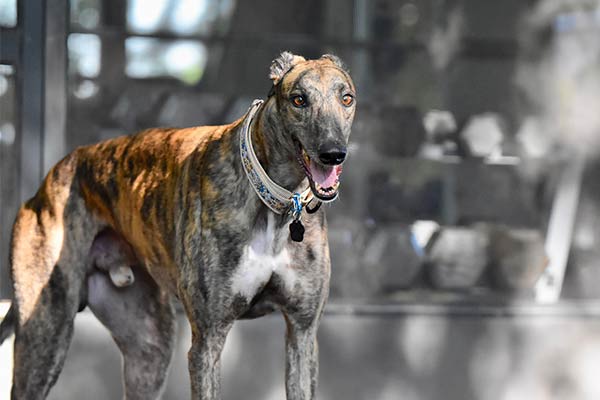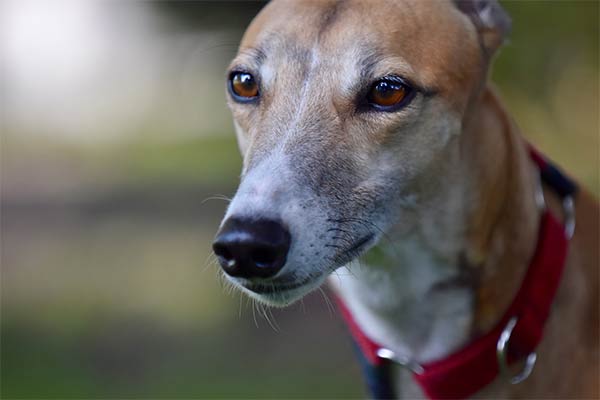There’s no kidding when people named the Greyhounds as the “cheetah of the dog world.” The Greyhound is mainly built for speed. Their narrow skulls, streamlined, muscular bodies, and shock-absorbing pads of their feet are made to go at high speeds.
Many artists, poets, and even kings are fascinated by their inverted S-shape bodies brought by their deep chest and tight waist. They are truly dogs with regal beauties—no wonder these dogs have been used as templates of several coursing hounds we know today.
These dogs may have a reputation for being energetic and fast. However, they’ll do well in any living conditions. These dogs love sleeping, and they’ll make a great companion even if you’re not very active.

Greyhound Breed Statistics
| Dog Breed Group | Hound Group |
| Breed Size | Medium |
| Height | 28-30 inches (male); 27-28 inches (female) |
| Weight | 65-70 pounds (male); 60-65 pounds (female) |
| Lifespan | 10-13 years |
Greyhound Breed Ratings
| Energy level | |
| Exercise needs | |
| Requires attention | |
| Playfulness | |
| Trainability | |
| Shedding | |
| Grooming | |
| Friendly with family | |
| Friendly with kids | |
| Friendly with strangers | |
| Friendly with other dogs | |
| Prey Drive |
Greyhound History
Greyhounds are ancient dogs whose history can be traced back to the Middle East and North Africa about 8000 years ago. There have been different explanations as to these dog’s names.
Some say that they have been named greyhounds as their original color was gray, which makes sense.
Others believe that the name came from the words “grei” and “hundr” which means dog hunter.
And finally, one theory points out that the name came from the term Greekhound, as it was the Greeks that brought the dogs to England.
However, no matter which of these three origins is true, the fact remains that these dogs have been admired by many ever since a long, long time ago. They have been mentioned by the Greeks, were found in ancient Egyptian art, and were even mentioned in the bible.
It’s believed that Greyhounds reached Europe around the Dark Ages. And due to their hunting skills, these dogs are protected by the law, and no one who lives within 10 miles of the King’s forest was allowed to own one.
As coursing and racing became popular in England, Greyhounds rose to popularity. They became known as the fastest dog, reaching a speed of 40 miles per hour.
Soon, the dogs were finally brought to America by Spanish explorers and British colonists, where they also thrived well. And by 1885, the American Kennel Club recognized the dog breed.
Greyhound racing has been popular in America until now. However, there have been controversies about how the dogs were abandoned, euthanized, or sold for experiments if they lost a race.
People have then made it an effort to find homes for retired racers, and it has been discovered that Greyhounds also make excellent family pets. Now, the dogs rank 145th as the most popular dog breed in the US.

Greyhound Temperament
Greyhounds generally have a wonderful temperament. They are gentle, independent, friendly, non-aggressive, and noble dogs.
Even if they do have a reputation for being fast, these dogs are usually calm and quiet indoors. Don’t be surprised if you see them snuggling comfortably on their beds to sleep. After all, it’s their favorite past-time.
Try to give them a time to run to their heart’s content once a day, because after that they surely won’t disturb you once they go back indoors. They usually prefer quiet and soft-spoken people, so avoid shouting and arguments when they’re around, as this might stress them out.
Greyhounds are also known to be polite with strangers. If he sees someone suspicious, they don’t bark, but stays by your side instead. They also don’t like fighting with other dogs, no matter the size; however, they tend to chase cats.
Early socialization will help make these dogs more well-rounded. It will also help build their confidence when they’re meeting new people or animals. You should be light-handed with the training and shower them with lots of praise and appreciation.
Greyhound Care Requirements
- Nutrition: Greyhounds don’t have any special dietary requirements. They can live in any type of diet as long as it’s high-quality and well-balanced. So, make sure only to buy high-quality ingredients for their everyday meals. Proteins are the most essential for their growth as this supports their muscles. You can get this from fresh animal meat like beef, lamb, or poultry. Next is fats for hair growth, and you can get this from fish and chicken oils. You should also find sources of carbohydrates for their energy, and don’t forget to add fruits and vegetables. If your dog is allergic to any food ingredients, be sure to stay away from those. For dog food and dog treats, You should only buy the premium quality ones. Don’t forget to check the label and ensure that it doesn’t contain fillers, additives, by-products, and ingredients they’re allergic to. Watch out for the amount of food you feed them a day. If possible, ask your vet for a guide about the right number of calories to serve your dog.
- Grooming: Greyhounds have short, smooth coats that require very minimal grooming. These dogs occasionally shed, which means you would only need to brush their coats occasionally too. Just to help keep the shedding to a minimum. Baths can be given once every few months, depending on your dog’s needs. Sometimes, just a rundown with a damp cloth on their coats should do. However, the ears should be cleaned regularly to avoid ear infections. Don’t forget the nails, and be sure to trim it once every two weeks. You don’t want those nails to get too long, as this will only cause pain and discomfort to your dog.
- Exercise: Greyhounds are energetic dogs. Yes, they can be your best home buddies, but there’s no denying the amazing speed this dog has. It’s essential that you give them regular exercise, and it’s best if you provide them with the opportunity to run at their heart’s content. This may mean finding a large, securely fenced yard (if you don’t have one) just so your Greyhound can enjoy it to its fullest. If you can’t find a securely fenced yard, you can take them biking, running, or jogging where they can run beside you. However, remember that these dogs are not built for endurance, so long-distance adventures may not be something good to offer.
- Health: Greyhounds are generally healthy dogs. However, like any other dog breed, there are certain conditions they can potentially get. As dog owners, it’s essential to be aware of what these are. Mainly, Greyhounds are susceptible to four diseases: Anesthesia Sensitivity, Hypothyroidism, Osteosarcoma, and Gastric Torsion. Other than these, there may also be other diseases like hip dysplasia, which don’t appear as commonly. We recommend meeting at least one of your dog’s parents to know any existing conditions your dog may get. You should also continuously monitor your dog’s behavior, and if you notice any changes, take him for a check-up immediately. It’s highly essential to give these dogs proper care and nutrition to keep them healthy always.
- Lifespan: The life expectancy of Greyhounds is 10-13 years.
Famous Greyhounds
- Steverino: The Lady Greyhound mascot of the Greyhound Corporation
- Cinderella May: A Greyhound with a Guinness World Record for the highest jump by a Dog
- Fanta: The fastest Greyhound on record with the highest speed of 50.5 miles per hour
- Cornwallis and Grim: Greyhounds owned by previous US Presidents, George Washington and Rutherford Hayes
Fun Facts about Greyhounds
- The Greyhound is an ancient dog breed that originated from ancient Egypt about 8000 years ago.
- They are the only dog breed mentioned in the Bible.
- They are the second fastest animal on earth, second to the Cheetah; these dogs can run up to 45 miles per hour.
- They are popular racing and coursing dogs.
- Noblemen and royalties were the only ones allowed to own a Greyhound before.
- During the time of King Canute, killing a Greyhound was punishable by death.
- They love to sleep.
- They are quiet dogs, so they rarely bark.
- They were recognized as an official breed by the American Kennel Club in 1885.
Check Out Other Hound Dog Breeds:
Afghan Hound, American English Coonhounds, American Foxhound, Basenjis, Basset Hound, Beagle, Black and Tan Coonhound, Bloodhound, Bluetick Coonhound, Borzois, Cirnechi dell’Etna, Dachshund, English Foxhound, Grand Basset Griffon Vendeens, Harrier, Ibizan Hound, Icelandic Sheepdogs, Irish Wolfhound, Norwegian Elkhound, Otterhound, Petit Basset Griffon Vendéen, Pharaoh Hounds, Plotts, Portuguese Podengo, Redbone Coonhound, Rhodesian Ridgeback, Salukis, Scottish Deerhounds, Sloughis, Treeing Walker Coonhound, Whippet

